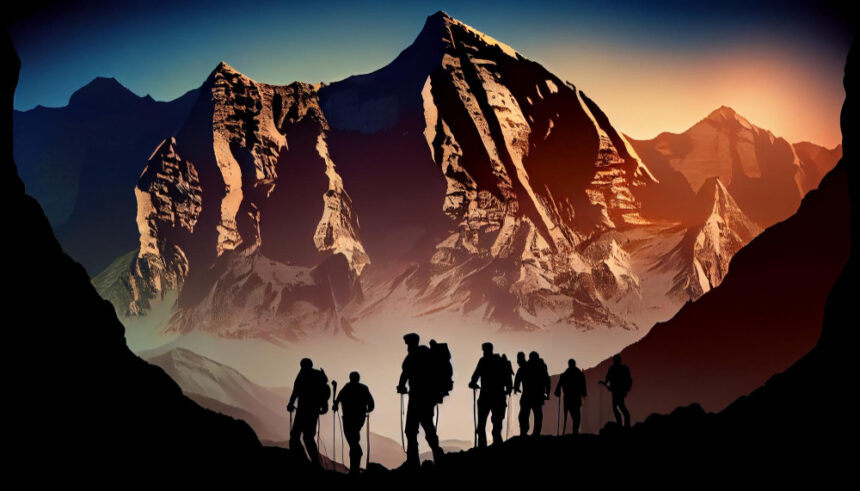Mountaineer Elisabeth Revol was rescued this weekend in Pakistan when she was trapped at an altitude of 6,000 m on Nanga Parbat.
One of two climbers who found themselves trapped on the very dangerous Nanga Parbat peak in northern Pakistan was found by rescuers this weekend and evacuated. Despite several attempts, rescuers were unable to save the second climber due to poor weather conditions and the high altitude.
On the night of Saturday, January 27 to Sunday January 28, French mountaineer Elisabeth Revol, 37, was rescued by a Polish rope team.
who went to meet him on the peak of more than 8,000 meters above sea level, the ninth highest peak in the world.
The search for Elisabeth Revol’s teammate, the Polish Tomasz Mackiewicz, had to be suspended. On Sunday January 28, the rescue team mainly focused on rescuing Elisabeth Revol, who was transported to Islamabad. The fate of Mackiewicz, who was making his seventh attempt to climb Nanga Parbat, remains uncertain.
After Elisabeth Revol’s appeal for help, a crowdfunding campaign was created by British mountaineer Masha Gordon to cover the costs of the rescue. In just a few hours, the page raised more than €119,000. The experienced duo was attempting the winter ascent of Nanga Parbat for the third time and was descending from the summit when they requested help by satellite phone on the night of Thursday January 25 to Friday January 26.
Suffering from frostbite and snow blindness and showing signs of cerebral and pulmonary edema, Tomasz Mackiewicz took refuge in a crevasse at 7,280 m above sea level, in the hope that help on land could reach him. him, while Elisabeth Revol, without water or food, continued the descent to reach the base camp.
Snow blindness, or photokeratitis, is caused by unprotected exposure of the eyes to ultraviolet rays that are reflected by snow. Frostbite, if left untreated, can cause nerve damage, lead to cases of gangrene, and even lead to amputations in the worst cases.
One of two climbers who found themselves trapped on the very dangerous Nanga Parbat peak in northern Pakistan was found by rescuers this weekend and evacuated. Despite several attempts, rescuers were unable to save the second climber due to poor weather conditions and the high altitude.
On the night of Saturday, January 27 to Sunday January 28, French mountaineer Elisabeth Revol, 37, was rescued by a Polish rope team.
who went to meet him on the peak of more than 8,000 meters above sea level, the ninth highest peak in the world. The search for Elisabeth Revol’s teammate, the Polish Tomasz Mackiewicz, had to be suspended.
On Sunday January 28, the rescue team mainly focused on rescuing Elisabeth Revol, who was transported to Islamabad. The fate of Mackiewicz, who was making his seventh attempt to climb Nanga Parbat, remains uncertain.
After Elisabeth Revol’s appeal for help, a crowdfunding campaign was created by British mountaineer Masha Gordon to cover the costs of the rescue.
In just a few hours, the page raised more than €119,000. The experienced duo was attempting the winter ascent of Nanga Parbat for the third time and was descending from the summit when they requested help by satellite phone on the night of Thursday, January 25 to Friday, January 26.
Suffering from frostbite and snow blindness and showing signs of cerebral and pulmonary edema, Tomasz Mackiewicz took refuge in a crevasse at 7,280 m above sea level, in the hope that help on land could reach him. him, while Elisabeth Revol, without water or food, continued the descent to reach the base camp.
Snow blindness, or photokeratitis, is caused by unprotected exposure of the eyes to ultraviolet rays that are reflected by snow. Frostbite, if left untreated, can cause nerve damage, lead to cases of gangrene, and even lead to amputations in the worst cases.
Mountaineer Alan Arnette described the rescue mission on his blog as a “superhuman effort.” The four mountaineers thus succeeded in an extraordinary rescue operation, climbing Nanga Parbat “at a speed of 121 meters per hour at more than 6,000 meters above sea level,” he wrote.
The challenge was to find them as quickly as possible. The group still took a break during the ascent, waiting for more lenient and stable weather conditions.
Deposited at an altitude of 5,200 m, they set off to meet Elisabeth Revol, climbing at night, in three and a half hours, a difference in altitude of more than 1,000 m on a dizzying slope.
In 2009, Elisabeth Revol lost another climbing companion, the Czech mountaineer Martin Minarik, aged 42. With him, she had reached the eastern pillar of Annapurna before Minarik disappeared during the descent. Elisabeth Revol then put her expeditions on hold.
A few years later, in January 2015, she reconnected with her Himalayan dreams and attempted her first ascent of Nanga Parbat with Tomasz Mackiewicz. Together, they climbed to an altitude of 7,800 m before giving up due to the weather.
Elisabeth Revol was rescued and treated; her life is out of danger.
Mark

